IATA: Middle East carriers had a 4.9% demand increase, which was lowest among regions

This was an increase from the 5.8% annual growth recorded in October 2017. Despite indicators pointing to air cargo having passed a cyclical growth peak, demand remains strong.
Freight capacity, measured in available freight tonne kilometers (AFTKs), rose by 4.0% year-on-year in November. This was the 16th consecutive month in which demand growth outstripped capacity growth, which is positive for industry load factors, yields, and financial performance.
The uptick in freight growth coincides with the traditional period of strong demand seen in the fourth quarter. November’s robust performance puts the air cargo industry on track to achieve its strongest operational and financial performance since the post-global financial crisis rebound in 2010. The Purchasing Managers Index (PMI) for manufacturing and export orders, which has tracked sideways for much of 2017, reached a seven-year high in the fourth quarter signifying that growth is carrying momentum into 2018.
"Air freight demand remains robust. November showed 8.8% year-on-year growth, keeping up the momentum that will make 2017 the strongest year for air cargo since 2010. And there are several indicators that 2018 will be a good year as well. In particular, buoyant consumer confidence, the growth of international e-commerce and the broad-based global economic upturn are cause for optimism as we head into the New Year," said Alexandre de Juniac, IATA’s Director General and CEO.
Middle East carriers had a 4.9% demand increase, which was the lowest among the regions. The market segment to and from North America continues to be affected by the now-lifted ban on personal electronic devices, as well as a wider impact stemming from the proposed travel restrictions to the US from certain countries. Capacity rose 4.3% and load factor lifted 0.4 percentage point to 70.1%.
International Passenger Markets
November international passenger demand rose 8.1% compared to the year earlier period, an increase from 7.3% in October. All regions showed growth, led for the third consecutive month by carriers in the Asia-Pacific region. Total capacity climbed 6.6%, and load factor increased 1.1 percentage points to 78.2%.
Asia-Pacific airlines' November traffic climbed 10.8% compared to the year-ago period, driven by strong regional economic growth and continuing expansion of options for travelers. Capacity increased 8.7% and load factor rose 1.5 percentage points to 78.6%.
European carriers saw demand increase by 7.9% in November 2017. Economic conditions in the region remain very favorable, with business confidence recently having risen to its strongest level in seven years. Capacity climbed 6.2% and load factor rose 1.3 percentage points to 81.9%, which was tied with Latin America as the highest load factor among the regions.
North American airlines' traffic climbed 6.4%, in November. Capacity rose 6.1% and load factor edged up 0.2 percentage point to 79.1%. The relatively vigorous economic backdrop is supporting outbound passenger demand, but this appears partly to be offset by a negative impact on inbound travel to the US from the additional security measures involved with traveling there.
Latin American airlines' November traffic climbed 7.2% compared to November 2016. This was broadly in line with the region's five-year average growth rate, although on a seasonally-adjusted basis, volumes are still below the peak level reached in July 2017. Capacity also increased by 7.2%, keeping load factor flat at 81.9%.
African airlines experienced a 7.9% rise in demand compared to November 2016. Volumes have started to trend upwards strongly again in seasonally-adjusted terms in recent months, in line with an improvement in business confidence in key economies including Kenya and Nigeria. Indicators in South Africa, by contrast, are still consistent with falling economic activity. Capacity rose 3.7% and load factor climbed 2.7 percentage points to 68.3%.
Domestic Passenger Markets
Domestic travel demand rose 7.8% in November 2017 compared to the same month in 2016, up from a 7.2% year-over-year increase in October. All markets showed growth, led again by India and China. Domestic capacity climbed 5.9%, and load factor improved 1.4 percentage points to 83.6%.
Stay up to date
Subscribe to the free Times Aerospace newsletter and receive the latest content every week. We'll never share your email address.

